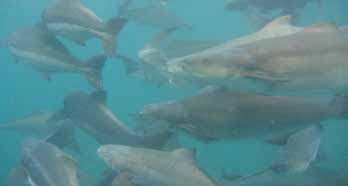Environmental groups are raising concerns about a new federal report on Canada’s $1 billion aquaculture industry, saying the study appears to be focused on ramping up production at the expense of the environment, as reported by Michael Macdonald from the Canadian Press.
A spokeswoman for the Atlantic Salmon Federation, which is opposed to the use of open-net pens in salmon farming, says the Senate report released Thursday calls for more research instead of tougher regulations and enforcement.
“We cannot wait years for research to give us the data and then have changes implemented,” Sue Scott said in an interview from St. Andrews, N.B.
“Research is important but we have known for about 15 years about the impact of (farmed salmon) escapees on wild Atlantic salmon. We’ve been out there with the data and it hasn’t made much of an impact on the government or the industry to improve operations.”
Scott said ocean-based salmon farms require more transparency and less self-regulation.
The Senate’s three-volume report offers 10 recommendations, including a call for a new federal Aquaculture Act and more research on finfish aquaculture and the impact of pesticides used on sea lice.
A spokeswoman for the Atlantic Salmon Federation, which is opposed to the use of open-net pens in salmon farming, says the Senate report released Thursday calls for more research instead of tougher regulations and enforcement.
“We cannot wait years for research to give us the data and then have changes implemented,” Sue Scott said in an interview from St. Andrews, N.B.
“Research is important but we have known for about 15 years about the impact of (farmed salmon) escapees on wild Atlantic salmon. We’ve been out there with the data and it hasn’t made much of an impact on the government or the industry to improve operations.”
Scott said ocean-based salmon farms require more transparency and less self-regulation.
The Senate’s three-volume report offers 10 recommendations, including a call for a new federal Aquaculture Act and more research on finfish aquaculture and the impact of pesticides used on sea lice.
 |
| Photo by ©Julia Manzerova on Flickr |
“This is particularly so in relation to transfer of pathogens from aquacultured to wild salmon.”
The Senate’s standing committee on fisheries, which studied the industry for 18 months, is also calling for a national database that would offer the public access to information about every aquaculture operator in the country.
Read more HERE.
The Aquaculturists
This blog is maintained by The Aquaculturists staff and is supported by the
magazine International Aquafeed which is published by Perendale Publishers Ltd
magazine International Aquafeed which is published by Perendale Publishers Ltd
For additional daily news from aquaculture around the world: aquaculture-news
















